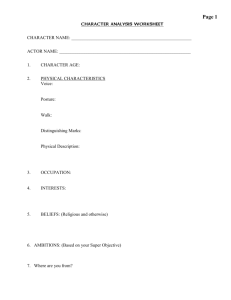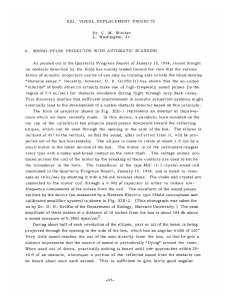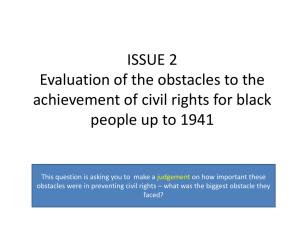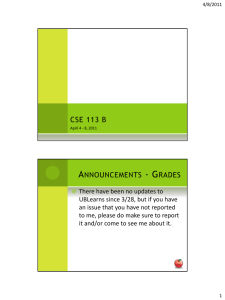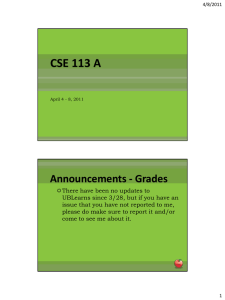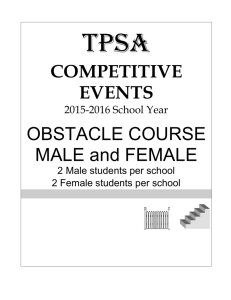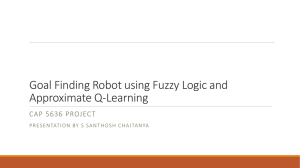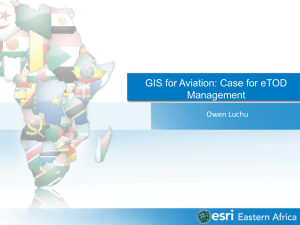Robust Execution of Bipedal Walking Tasks from Biomechanical
advertisement
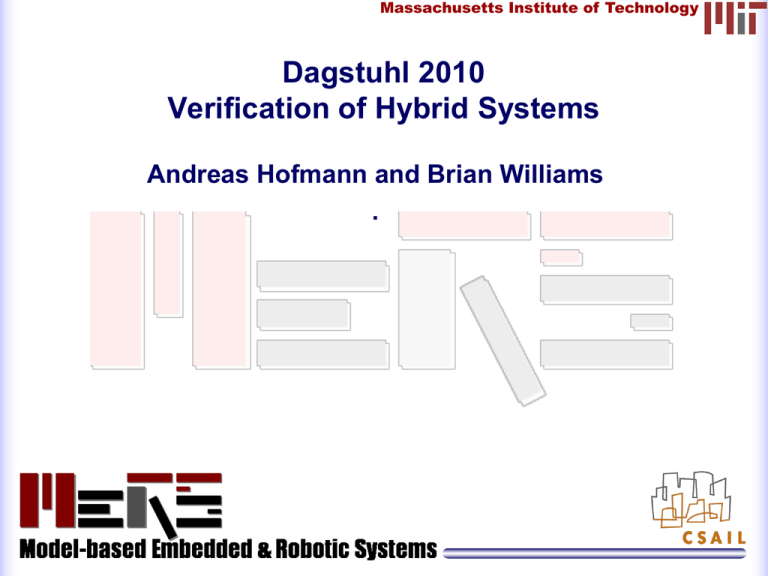
Massachusetts Institute of Technology Dagstuhl 2010 Verification of Hybrid Systems Andreas Hofmann and Brian Williams . Validation Problem Statement • Probabilistic Certificate of Validation – Probability that a particular design will successfully pass a use case, or set of use cases. • Examples: probability that a vehicle – will move at a top speed > 60 mph for one hour; – will accelerate to 60 mph in less than 3 seconds; – will successfully execute a mission plan in an allotted time. Validation: Problem Statement • Given a use case expressed as a flexible plan, Q , • a plant model, M, representing the dynamic behavior of a design, – also includes disturbance model – also represents actuation limits • Compute probabilistic certificate of validation Pvalid Q M • Problem is related to, but distinct from Controller Synthesis Problem (derive C given Q , M ) • Also distinct from problem of finding a single trajectory that satisfies Q and M Example Use Case • Use case represented as a Qualitative State Plan (QSP) – Events, episodes, temporal constraints – Episodes have state-space constraints on initial, goal, and operating regions Operating Constraints Goal Constraints Accelerate Maintain speed Brake Steer 1 Steer 2 Steer 3 Top speed reached (x’ > 200) Finish line crossed (x > 1300) Stopped (x’ = 0) Stay in lane (ymin < y < ymax) Stay in lane (ymin < y < ymax) Stay in lane (ymin < y < ymax) x is forward position y is lateral position Example Plant Models x Ax Bu • • Aerodynamic resistance, rolling resistance, resistance due to grade Actuation limits • Tractive force limited by coefficient of friction with ground, normal load • Also by engine torque, gearing • x [ x, x , y, ]T u [ x, ]T x 0 A x x 0 Hybrid discrete/continuous 0 x Bu 0 Disturbance Model • Incorporated into Plant Model – Noise with arbitrary distribution at the input. – w is noise signal with arbitrary probability distribution. Uncertainty via Stochastic Models Continuous state x c ,t xt y t xt y t (x0,y0) Obstacle 1 Random initial state Obstacle 2 Goal Region Continuous dynamics xx ~ fp(u xct ,,0x)c,t ) c,tc,10 xc,t 1 f (ut , xc,t ) 7 Uncertainty via Stochastic Models Continuous state x c ,t xt y t xt y t (x0,y0) Obstacle 1 Obstacle 2 Goal Region Continuous dynamics xc,0 ~ p(xc,0 ) xxc,ct,t11 ff(u (ut ,t ,xxc,ct,,t) t ) t ~ p( t ) Random disturbance process 8 Uncertainty via Stochastic Models Continuous state x c ,t xt y t xt y t Obstacle 1 Obstacle 2 Goal Region Continuous dynamics xc,0 ~ p(xc,0 ) xc,t 1 ft (ut , xc,t , t ) t ~ p( t ) 9 Robust Control • “Find optimal, robust sequence of control actions” Obstacle 1 Obstacle 1 Obstacle 2 Obstacle 2 Goal Region Goal Region p(failure) ≤ δ Optimal but not Robust Optimal and Robust Robustness expressed using chance constraints - Operator specifies maximum probability of failure δ 10 Problem: Synthesize Controller for a Biped that is Robust to Disturbances Example QSP for Biped start finish [t_lb, t_ub] CM Qualitative State Plan left toe-off lf l1 Left Foot cmcm1 lf l 2 right toe-off rf r1 right heel-strike Right Foot Compute u such that resulting state trajectory satisfies plan -state constraints -temporal constraints left heel-strike rf r 2 rf r 2 Plant u? CM des x f x, u hx, u 0 Flow Tubes for Center of Mass y t y Fwd. CM y y t Lat. CM Transform Stochastic Plant Model into an Equivalent Deterministic One • Use set bounds to represent hard limits on noise disturbance. • Set bounds cover n of noise distribution. • Set bounds on input noise translate to safety bounds on input. • Corresponding safety bounds on state trajectories must be determined. Compute Reach Sets • Perform deterministic reach set analysis on QSP using plant model with input noise set bounds. – Start from goal region. – Compute backward reach sets for each time increment back from goal. • Polytope for time t(k-j) represents all states (and control inputs) on feasible trajectories at j time increments before goal time. – Feasible with probability Psuccess Relation Between State and Duration t y t y y y Fwd. CM Lat. CM y y Controllable initial region Controllable initial region Goal region Goal region y y Key Questions t y t y y y y y Controllable initial region Controllable initial region Goal region Goal region y • • • How do disturbances affect activity state and duration? How much state and temporal flexibility, and actuation capability is necessary to achieve desired probabilistic certificate? How can compile time verification be leveraged for runtime verification and control? y


